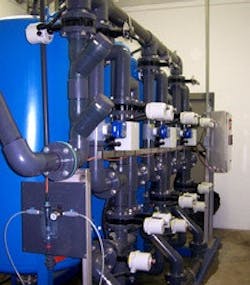In 2005, the Michigan Department of Environmental Quality (MDEQ) reported more than 200 public water systems that at one time exceeded the new arsenic treatment standard of 10 parts per billion (ppb). A number of sites have taken measures to mitigate this situation by drilling new wells, connecting to other available public water sources or installing new treatment.
In August 2007, AdEdge Technologies, Inc. was selected by Tri-County Drilling to supply a packaged arsenic, iron and manganese treatment system for the Lakeview Estates MHP in Durand, Mich. The system, with 239 connections, is served by 14 low-producing wells that combine to deliver an up to 200-gal-per-minute (gpm) design flow or firm capacity to the mobile home park. The raw water has arsenic at 20 ppb, iron at 0.5 parts per million (ppm) and manganese at 0.1 ppm, all exceeding primary and secondary drinking water standards. A 4,000-gal hydropneumatic storage tank inside the well house provides temporary storage prior to distribution. Only chlorination and sequestration with polyphosphates were in place prior to the arsenic treatment system addition.
The packaged system uses an NSF 61-certified manganese dioxide media that has been proven successful for co-contaminant removal. Conventional adsorption was eliminated from consideration based on the high iron and manganese levels in the raw water, which could potentially foul or interfere with adsorption technology.
The AD26 technology was selected based on overall cost, its small footprint and simplicity of operation. The MDEQ permit was granted in November 2007.
To house the equipment, Tri-County Drilling constructed a new block building expansion as part of the project. In addition, new radio frequency well pump controls and piping upgrades were performed.
Treatment System
The arsenic treatment train consists of a completely integrated, packaged treatment system with three vessels in parallel to treat up to 200 gpm. The 36-in.-diameter treatment vessels are made of epoxy-lined carbon steel with an automated valve harness and piping. The technology concurrently removes the naturally occurring iron, manganese and arsenic in a single process step. Only prechlorination with liquid sodium hypochlorite is needed to facilitate contaminant removal and for disinfection. The process needs approximately 15 to 30 seconds of contact time for chlorine, considerably less than other approaches that require 10 to 30 minutes and a separate contact tank.
The media is not exhausted but simply backwashed two times per week, so it can be used multiple times. Backwash water containing the nonhazardous, precipitated insoluble particulates is managed by the site’s existing wastewater treatment lagoon.
Installation was completed late in fourth quarter of 2007, and the system was officially started up in January 2008. Since operations began, the system has consistently met all the EPA MCLs for arsenic, iron and manganese.
Arsenic in the treated water has been recorded consistently below detection ( <2 ppb). The engineer at the site performs monitoring and periodic sampling of the system in accordance with the MDEQ permit. Checking the system, replenishing chlorine and monitoring the system require less than one hour of operating time per week.
In addition to arsenic removal, the residents have experienced a dramatic improvement in the aesthetic quality of the water since iron and manganese no longer exist in the distribution water. It was also determined that the polyphosphate addition for sequestering the iron can be eliminated for additional cost savings. The expected operating cost for the system—including prorated media replacement after 10 years, chemicals and utilities—is less than $0.15 per 1,000 gal or less than $1.25 per connection per month, making the technology extremely attractive from an O&M standpoint.
The technology has been successfully deployed on many high-arsenic, iron and manganese wells to date and also on three full-scale EPA arsenic demonstration projects.
| Related Searches from WaterInfoLink.com Arsenic Treatment | Iron | AdEdge Technologies | Manganese | Tri-County Drilling |
